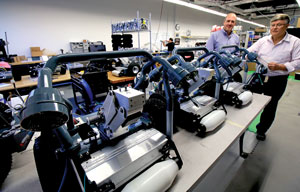11/26/2014
Birth of a Robot
Chris Beytes

Harveys number HAI-1245, 1246 and 1247 await final assembly by Don Haras (right), manufacturing test engineer at the Harvest Automation facility in Billerica, Massachusetts. That’s CEO John Kawola looking on. “Harvey” is the pet name for Harvest’s HV-100 plant moving robot. Launched just two years ago, there are now some 150 HV-100s at work at 27 nurseries and greenhouses across the country.
It’s fascinating that Harvest got into nursery and greenhouse automation, considering the co-founders’ experience is in dust bunnies and particle accelerators (Joe Jones helped invent the now-famous Roomba robot vacuum cleaner and Charlie Grinnell was a lead engineer on a $300 million particle detector at CERN in Switzerland). So how did their first robot wind up spacing boxwoods?
“When [Joe and Charlie] first started, they weren’t necessarily focused on nursery and greenhouse, it was more about mobile autonomous robots doing repetitive, difficult work,” explains John.
The engineers explored other fields, including construction, mining and warehousing, before settling on agriculture, where they learned that two-thirds of the market—field crops—has already been mechanized by John Deere. But the remaining third—nursery and greenhouse, fruits and vegetables, trees, even wine grapes—are high-labor fields ripe for automating. They selected nursery and greenhouse because it’s the single largest specialty crop category.
After talking to growers, they developed the HV-100 platform. The first robots sold in late 2012 to Willoway Nursery in Ohio and McCorkle Nursery in Georgia.
Initially, the inventors of Harvey felt its strong suit would be larger, heavier containers—3 and 5 gal., primarily. But the opposite has proven to be true: there are many more 1-gal. pots needing to be moved, which has led to their popularity with large greenhouse growers who grow hundreds of thousands of fall mums and large poinsettias. Now, their business is split 50/50 between nursery and greenhouse.
What’s next? Maybe fruit, says John. They’re running trials with two California fruit growers, producing fruit such as strawberries in pots rather than the field, and using Harveys to bring the pots to the workers for picking. He says the potential for labor and space savings “has raised a lot of eyebrows.”
GT